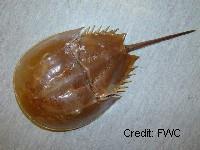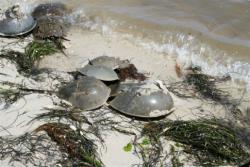As Horseshoe Crabs Near Mating Season, A Bit of Background
Editor’s Note: Today’s feature comes to The Outdoor Wires from the Florida Fish and Wildlife Commission (FWC).
from The Fishing Wire
Four species of horseshoe crabs exist today. Only one species, Limulus polyphemus, is found in North America along the Atlantic and Gulf coasts from Maine to Mexico. The other three species are found in Southeast Asia. Horseshoe crabs are not true crabs at all. Horseshoe crabs are more closely related to arachnids (a group that includes spiders and scorpions) than to crustaceans (a group that includes true crabs, lobsters, and shrimp). Horseshoe crabs are often called “living fossils” because fossils of their ancestors date back almost 450 million years–that’s 200 million years before dinosaurs existed.
Despite inhabiting the planet for so long, horseshoe crab body forms have changed very little over all of those years.
The strange anatomy of the horseshoe crab is one of this animal’s most notable aspects. Unfortunately, the long, thin, spike-like tail of horseshoe crabs has given this species an unfavorable reputation. Many people view horseshoe crabs as dangerous animals because they have sharp tails. In reality, horseshoe crabs are harmless. Their tails are used primarily to flip themselves upright if they are accidentally overturned.
Horseshoe crabs nesting on Florida BeachHorseshoe crabs nest on beaches in Florida and mid-Atlantic states.Horseshoe crabs are known for their large nesting aggregations, or groups, on beaches particularly in mid-Atlantic states such as Delaware, New Jersey and Maryland in the spring and summer. Horseshoe crabs can nest year-round in Florida, with peak spawning occurring in the spring and fall. When mating, male horseshoe crabs move parallel to the shoreline on sandy flats and intercept females as they pass by. A male attaches himself to the top of a female’s shell by using his specialized front claws, in a position known as amplexus, and together they crawl to the beach. The male fertilizes the eggs as the female lays them in a nest in the sand. Some males (called satellite males) do not attach to females but still have success to fertilizing the female’s eggs as they swarm around the amplexed pair. Most of this nesting activity takes place during high tides in the three days before and after a new or full moon.
Horseshoe crab larvae emerge from their nests several weeks after the eggs are laid. Juvenile horseshoe crabs resemble adults except that their tails are proportionally smaller. The young and adult horseshoe crabs spend most of their time on the sandy bottoms of intertidal flats or zones above the low tide mark and feed on variousinvertebrates.
Why are horseshoe crabs important?
Horseshoe crabs are an important part of the ecology of coastal communities. During the nesting season, especially in the mid-Atlantic States, horseshoe crab eggs become the major food source for migrating birds. Over 50 percent of the diet of many shorebird species consists of horseshoe crab eggs. Many bird species in Florida have been observed feeding on horseshoe crab eggs. In addition, many fish species rely on horseshoe crab eggs for food.
Horseshoe crabs are extremely important to the biomedical industry because their unique, copper-based blue blood contains a substance called Limulus amebocyte lysate. The substance, which coagulates in the presence of small amounts of bacterial toxins, is used to test for sterility of medical equipment and virtually all intravenous drugs. Research on the compound eyes of horseshoe crabs has led to a better understanding of human vision. The marine life fishery collects live horseshoe crabs for resale as aquarium, research, or educational specimens, and the American eel and whelk fisheries use horseshoe crabs extensively as bait along many parts of the Atlantic coast.
Threats to horseshoe crabs and research efforts
Horseshoe crab numbers are declining throughout much of the species’ range. In 1998, The Atlantic States Marine Fisheries Commission developed a Horseshoe Crab Fishery Management Plan that requires all Atlantic coastal states to identify horseshoe crab nesting beaches. Currently, with the help of the public, biologists at the Fish and Wildlife Research Institute are trying to document nesting sites of horseshoe crabs throughout the state. If you are interested in becoming more involved with the horseshoe crab survey, please visit the Survey for Horseshoe Crab Nesting Beaches in Florida for more information.

